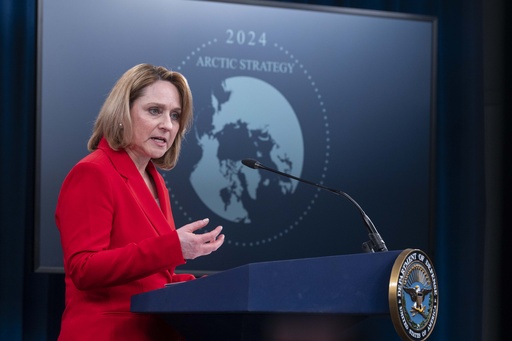WASHINGTON (AP) — The U.S. Defense Department must invest more to upgrade sensors, communications and space-based technologies in the Arctic to keep pace with China and Russia who are increasingly operating there, including in joint military exercises, a new Pentagon strategy says.
Saying that now is “a critical time” for the Arctic, Deputy Defense Secretary Kathleen Hicks told reporters Monday that climate change, increased activity by adversaries and degrading U.S. infrastructure are forcing the department to rethink how to keep the Arctic secure and ensure troops are well-equipped and protected.
The Arctic strategy is short on specifics, but broadly pushes for greater spending on high-tech sensor and radar systems, a range of military equipment, and continued investment in Pituffik Space Base, the U.S. Space Force base in the northwest corner of Greenland. And it relies on growing partnerships with Canada and a number of NATO allies in the north.
Defense Department leaders have, for more than the past decade, warned that the U.S. needs to step up its activities in the Arctic to better compete with China and Russia as climate change makes the frigid region more accessible.
But the remote northern expanse presents an array of challenges, including demands for deep-water ports, weapons, drones and equipment that can withstand the climate, and additional ships that can handle the cold waters and break through the ice.
The U.S. has also struggled with Cold War-era Defense and State Department infrastructure that is degrading in the frigid weather, and erosion on the coasts.
The cold and increasingly unpredictable weather also restricts military training and affects equipment. And the region, which has limited satellite coverage, requires a far more expansive array of sensors for communications and military awareness.
“Slowly over time, there’s been a bit of a greater awakening in the department,” said Iris Ferguson, the deputy assistant defense secretary for the Arctic. “Now we’re getting into the nitty gritty of how you implement a strategy.”
The report notes that the Arctic is warming “more than three times faster than the rest of the world” and could see its first “practically ice-free summer” by 2030. As the ice melts, the increased traffic, it said, will boost the risks of accidents, miscalculation and environmental degradation.
Hicks couldn’t quantify the increased activity by Russia and China in the region, but she called the growing cooperation between the two troubling. In 2022 and 2023, they conducted joint military exercises off the coast of Alaska.
Meanwhile, the melting ice caps are opening sea lanes for longer periods of time each year, making lucrative oil and gas deposits more accessible. And China has provided critical funding to Russia for energy exploration.
China has also increased its own activity in the region, including by its three icebreaker ships that do civil-military research in the region. According to the report, Chinese vessels have tested underwater drones and polar-capable aircraft there.
Russia, which has the largest amount of Arctic territory and has the most developed military presence there, including important strategic nuclear capabilities, such as its submarine-launched ballistic missile force.
Going forward, the strategy says the department will review options for better sensors, and new space-based missile-warning and observational systems with greater polar coverage. Insufficient investments in early warning and air defense sensors in the Arctic will increase risks to the U.S. homeland, the report warns.
This website uses cookies so that we can provide you with the best user experience possible. Cookie information is stored in your browser and performs functions such as recognising you when you return to our website and helping our team to understand which sections of the website you find most interesting and useful.
